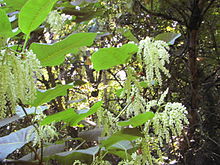Giant knotweed
| Fallopia sachalinensis | |
|---|---|
 |
|
| Scientific classification | |
| Kingdom: | Plantae |
| (unranked): | Angiosperms |
| (unranked): | Eudicots |
| (unranked): | Core eudicots |
| Order: | Caryophyllales |
| Family: | Polygonaceae |
| Genus: | Fallopia |
| Species: | F. sachalinensis |
| Binomial name | |
|
Fallopia sachalinensis (F.Schmidt) Ronse Decr. 1988 |
|
| Synonyms | |
|
|
Fallopia sachalinensis (giant knotweed or Sakhalin knotweed Japanese オオイタドリ ooitadori, Russian Горец сахалинский, Гречиха сахалинская; syn. Polygonum sachalinense F.Schmidt, Reynoutria sachalinensis (F.Schmidt) Nakai) is a species of Fallopia native to northeastern Asia in northern Japan (Hokkaidō, Honshū) and the far east of Russia (Sakhalin and the southern Kurile Islands).
Fallopia sachalinensis is a herbaceous perennial plant growing to 2–4 m (79–157 in) tall, with strong, extensively spreading rhizomes forming large clonal colonies. The leaves are some of the largest in the family, up to 15–40 cm (6–15.5 in) long and 10–28 cm (4–11 in) broad, nearly heart-shaped, with a somewhat wavy, crenate margin. The flowers are small, produced on short, dense panicles up to 10 cm (4 in) long in late summer or early autumn; it is gynodioecious, with male and female (male sterile) flowers on separate plants. The species is closely related to the Japanese knotweed, Fallopia japonica, and can be distinguished from it by its larger size, and in its leaves having a heart-shaped (not straight) base and a crenate margin. Fallopia sachalinensis has a chromosome count of 2n=44.
The shoots are tender and edible. It was introduced to Europe and grown in many botanic gardens. It came prominently into notice about 1893, when a drought in western Europe caused a decided shortage in forage for cattle. This plant was little affected, and since its tender shoots and leaves were eaten by stock, the plant was widely grown experimentally as a forage crop. It has proved less useful than was predicted, and its deliberate cultivation has been almost entirely abandoned. It has, however, like F. japonica, proved to be an invasive weed in several areas.
...
Wikipedia
